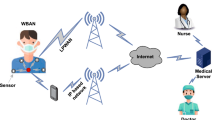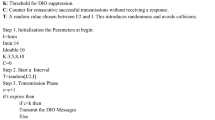Abstract
The presence of hidden nodes degrades the performance of wireless networks due to an excessive amount of data frame collisions. The IEEE 802.15.4 medium access control (MAC) protocol, which is widely used in current wireless sensor networks, does not provide any hidden node avoidance mechanisms and consequently could lead to severe performance degradation in networks with hidden nodes. This paper presents a simple technique based on discrete-time Markov chain analysis to approximate the throughput of IEEE 802.15.4 MAC protocol in the presence of hidden nodes. Using different network configurations, we validate the applicability of the proposed analysis for generic star-topology networks. Based on the analysis, the effects of network size, topology, frame length and frame arrival rate on the throughput of the system are investigated.

















Similar content being viewed by others
Notes
The beacon-enabled mode is widely used with WSNs in particular for synchronised monitoring applications [22]
A similar DTMC based analysis has been proposed in [3] to model the common channel in IEEE 802.15.4 star topology networks when all nodes share the same carrier sensing range. Because of the absence of hidden nodes, the DTMC presented in [3] has a less number of states, and its transition probabilities can be easily derived by modelling the behaviour of only a single node.
BO = 6 is only used as an input for simulations. There is no significant impact of the value of BO parameter on the protocol’s throughput in always active networks (i.e., networks where beacon order (BO) = superframe order (SO)), in particular for higher BOs [3].
Fairness indicates how fair a node in a given group gets the opportunity to contribute to the network throughput. For a given network, Fairness of Group j is expressed as
$$Fairness\, of\, Group\, j = \frac{Th_{max-network} - Th_{min-Group\, j}}{Th_{max-network}}$$where Th max-network and \(Th_{min-Group\; j}\) represent the maximum throughput value contributed by a node from the entire network and the minimum throughput value contributed by a node from that particular group, respectively.
Nodes in Fig. 11(a) and (b) are numbered for the simplicity of explanation.
We assume symmetric hearing between nodes, i.e., Node A hears Node B \(\Longleftrightarrow\) Node B hears Node A Node A cannot hear Node B \(\Longleftrightarrow\) Node B cannot hear Node A.
References
IEEE Std 802.15.4 (Revision of IEEE Std 802.15.4-2003). (2006). Wireless medium access control (MAC) and physical layer (PHY) specifications for low-rate wireless personal area networks (WPANs).
Park, T., Kim, T., Choi, J., Choi, S., & Kwon, W. (2005). Throughput and energy consumption analysis of IEEE 802.15.4 slotted CSMA/CA. Electronics Letters, 41(18), 1017–1019.
Ramachandran, I., Das, A. K., & Roy, S. (2007). Analysis of the contention access period of IEEE 802.15.4 MAC. ACM Transactions on Sensor Network, 3(1), Aricle 4.
Pollin, S., Ergen, M., Ergen, S., Bougard, B., Der Perre, L., Moerman, I., Bahai, A., Varaiya, P., & Catthoor, F. (2008). Performance analysis of slotted carrier sense IEEE 802.15.4 medium access layer. IEEE Transactions on Wireless Communications, 7(9), 3359–3371.
Singh, C., Kumar, A., & Ameer, P. (2008). Performance evaluation of an IEEE 802.15.4 sensor network with a star topology. Wireless Networks, 14(4), 543–568.
He, J., Tang, Z., Chen, H. H., & Zhang, Q. (2009). An accurate and scalable analytical model for IEEE 802.15.4 slotted CSMA/CA networks. IEEE Transactions on Wireless Communications, 8(1), 440–448.
Tobagi, F., & Kleinrock, L. (1975) Packet switching in radio channels: Part II—the hidden terminal problem in carrier sense multiple-access and the busy-tone solution. IEEE Transactions on Communications, 23(12), 1417–1433.
Tseng, H.-W., Yang, S.-C., Yeh, P.-C., & Pang, A.-C. (2011). A cross-layer scheme for solving hidden device problem in IEEE 802.15.4 wireless sensor networks. IEEE Sensors Journal, 11(2), 493–504.
Pešović, U., Mohorko, J., Benkič, K., & Čučej, Z. (2009). Effect of hidden nodes in IEEE 802.15.4/ZigBee wireless sensor networks. In Proceedings of 17th telecommunications forum (TELFOR), 161–164.
Harthikote-Matha, M., Banka, T., & Jayasumana, A. P. (2007). Performance degradation of IEEE 802.15.4 slotted CSMA/CA due to hidden nodes. In Proceedings of conference on local computer networks (LCN), pp. 264–266.
Woon, W. T. H., & Wan, T. C. (2007). Performance evaluation of IEEE 802.15.4 ad-hoc wireless sensor networks: Simulation approach. In Proceedings of IEEE international conference on systems, man and cybernetics, vol. 2, pp. 1443–1448.
Goyal, M., Rohm, D., Xie, W., Hosseini, S., Trivedi, K., Bashir, Y., & Divjak, A. (2011). A stochastic model for beaconless IEEE 802.15.4 MAC operation. Computer Communications, 34(12), 1460–1474.
Di Marco, P., Park, P., Fischione, C., & Johansson, K. (2010). Analytical modelling of IEEE 802.15.4 for multi-hop networks with heterogeneous traffic and hidden terminals. In Proceedings of IEEE global telecommunications conference (GLOBECOM), pp. 1–6.
Di Marco, P., Park, P., Fischione, C., & Johansson, K. (2012). Analytical modelling of multi-hop IEEE 802.15.4 networks. IEEE Transactions on Vehicular Technology, 61(7), 3191–3208.
IEEE Standard for Information Technology-Telecommunications and Information Exchange Between Systems-Local and Metropolitan Area Networks-Specific Requirements—Part 11: Wireless LAN Medium Access Control (MAC) and Physical Layer (PHY) Specifications (2007).
Wu, H., Zhu, F., Zhang, Q., & Niu, Z. (2006). Analysis of IEEE 802.11 DCF with hidden terminals. In Proceedings of IEEE global telecommunications conference (GLOBECOM), pp. 1–5.
Hung, K.-L., & Bensaou, B. (2011). Throughput analysis and bandwidth allocation for IEEE 802.11 WLAN with hidden terminals. Journal of Parallel and Distributed Computing, 71(9), 1201–1214.
Kim, T., & Lim, J.-T. (2009). Throughput analysis considering coupling effect in IEEE 802.11 networks with hidden stations. IEEE Communications Letters, 13(3), 175–177.
Yang, J. W., Kwon, J. K., Hwang, H. Y., & Sung, D. K. (2009). Goodput analysis of a WLAN with hidden nodes under a non-saturated condition. IEEE Transactions on Wireless Communications, 8(5), 2259–2264.
Ekici, O., & Yongacoglu, A. (2008). IEEE 802.11a throughput performance with hidden nodes. IEEE Communications Letters, 12(6), 465–467.
Ray, S., Starobinski, D., & Carruthers, J. B. (2005). Performance of wireless networks with hidden nodes: A queuing-theoretic analysis. Computer Communications, 28(10), 1179–1192.
Wijetunge, S., Gunawardana, U., & Liyanapathirana, R. (2012).Investigation of data transmission reliability of IEEE 802.15.4 based wireless sensor networks with synchronised periodic data. In Proceedings of the international conference on computer and information sciences (ICCIS), vol. 2, pp. 619–624.
Wijetunge, S., Gunawardana, U., & Liyanapathirana, R. (2011). Throughput analysis of IEEE 802.15.4 MAC protocol in the presence of hidden nodes. In Proceedings of 11th international symposium on communications and information technologies (ISCIT), pp. 303–308.
ns-2, The Network Simulator. (2011). http://isi.edu/nsnam/ns/.
Bencini, L., Collodi, G., Di Palma, D., Manes, G., & Manes, A. (2010). An embedded wireless sensor network system for cultural heritage monitoring. In Proceedings of fourth international conference on sensor technologies and applications (SENSORCOMM), pp. 185–190.
Liang, L., Huang, L., Jiang, X., & Yao, Y. (2008). Design and implementation of wireless smart-home sensor network based on ZigBee protocol. In Proceedings of international conference on communications, circuits and systems (ICCCAS), pp. 434–438.
Franceschinis, M., Spirito, M., Tomasi, R., Ossini, G., & Pidala, M. (2008). Using WSN technology for industrial monitoring: A real case. In Proceedings of second international conference on sensor technologies and applications (SENSORCOMM), pp. 282–287.
Hwang, L., Sheu, S., Shih, Y., & Cheng, Y. (2005). Grouping strategy for solving hidden node problem in IEEE 802.15.4 LR-WPAN. In Proceedings of first international conference on wireless internet, pp. 26–32.
Kouba, A., Severino, R., Alves, M., & Tovar, E. (2009). Improving quality-of-service in wireless sensor networks by mitigating hidden-node collisions. IEEE Transactions on Industrial Informatics, 5(3), 299–313.
Golmie, N., Cypher, D., & Rebala, O. (2005). Performance nalysis of low rate wireless technologies for medical applications. Computer Communications, 28(10), 1266–1275.
Author information
Authors and Affiliations
Corresponding author
Additional information
Part of this paper has been published in the Proceedings of the 11th International Symposium on Communications and Information Technologies (ISCIT) 2011 with the title “Throughput Analysis of IEEE 802.15.4 MAC Protocol in the Presence of Hidden Nodes”.
Appendices
Appendix 1
In [3], Ramachandran et al. analyse the slotted CSMA/CA mechanism in star-topology IEEE 802.15.4 networks where all nodes share the same carrier sensing range (i.e., networks with no hidden nodes). In such networks,
the probability p c i|i that the channel is idle at the next backoff slot given that it is idle at the current backoff slot has been computed in [3] by noting that
where p c i and p c i|b are the probabilities that the channel is sensed idle and the channel is idle at the next backoff slot given that it is busy at the current backoff slot, respectively. The probability p c i|b is equal to 1/L where L is the length of the data frame in terms of number of backoff slots. By substituting p c i|b = 1/L in (25), it has been shown that
Then, the probability that any node begins transmission, given that the channel has been idle for two consecutive backoff slots, has been given as
where p n t and p c ii are the probabilities that an individual node transmits in a given backoff slot and the channel remains idle for two consecutive backoff slots, respectively. The last equality in (27) has been obtained using the expression for p c i|i in (26). The probabilities p c i and p n t in (27) have been computed by solving the steady state equations of the node state DTMC and channel state DTMC developed in [3].
Appendix 2
Simulated aggregate network throughput of six different network configurations of 12-node network, 20-node network, and 30-node network are compared in Figs. 18, 19 and 20, respectively. In all three networks, the network configurations that have similar average number of hidden nodes (h avg ) show similar throughput performance [see Figs. 18(g), 19(g), 20(g)].
Rights and permissions
About this article
Cite this article
Wijetunge, S., Gunawardana, U. & Liyanapathirana, R. Throughput analysis of IEEE 802.15.4 beacon-enabled MAC protocol in the presence of hidden nodes. Wireless Netw 20, 1889–1908 (2014). https://doi.org/10.1007/s11276-013-0637-2
Published:
Issue Date:
DOI: https://doi.org/10.1007/s11276-013-0637-2







